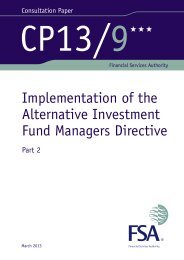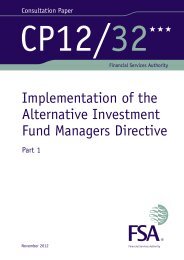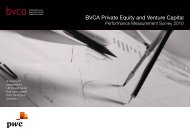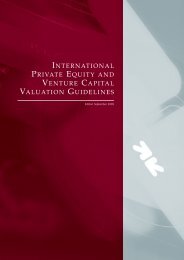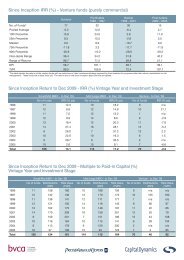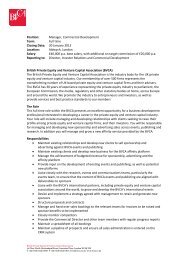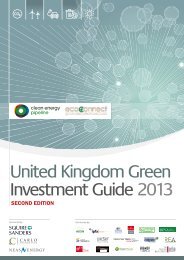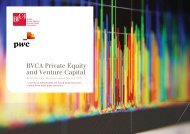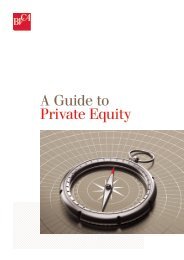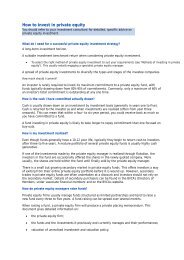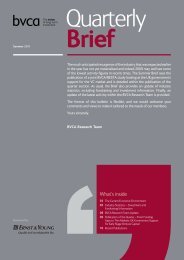fundraising special - BVCA admin
fundraising special - BVCA admin
fundraising special - BVCA admin
Create successful ePaper yourself
Turn your PDF publications into a flip-book with our unique Google optimized e-Paper software.
industry<br />
index<br />
The real reasons<br />
to invest in<br />
private equity<br />
‘The real reasons to invest in private equity’,<br />
is a study by Oliver Gottschalg at HEC Paris.<br />
This study uses data from 701 mature<br />
buyout funds, based in the US and EU, with<br />
an aggregate size of US$360bn. It uses a<br />
modified internal rate of return (MIRR), which<br />
makes assumptions about the financing<br />
and re-investment rates that funds face: in<br />
particular, cash inflows are re-invested at<br />
the annualised rate of market return over<br />
the remaining life of the fund, and outflows<br />
are financed at the annualised market<br />
return over the life of the fund so far. These<br />
assumptions are important when calculating<br />
MIRRs, but the authors’ sensitivity analysis<br />
suggests that they are not critical in terms of<br />
his broad results.<br />
Gottschalg decomposes MIRRs in a similar<br />
way to the <strong>BVCA</strong>-funded paper (Private<br />
Equity Fund Level Return Attribution:<br />
Evidence from UK Based Buyout Funds),<br />
although he splits timing and industrymatching<br />
into two separate categories,<br />
giving five in total.<br />
Using the whole sample, Gottschalg finds an<br />
average buyout MIRR of 7.6%, compared with<br />
an industry-matched leveraged return of<br />
6.8%, indicating alpha of just 80bps. Although<br />
this is statistically significant, the author<br />
notes that it probably does not compensate<br />
for illiquidity and unpredictability. However,<br />
the paper also finds that top-quartile<br />
funds deliver a higher MIRR of 13.6%, and<br />
significantly outperform equally risky public<br />
market investments, which return 8.5%. This<br />
alpha estimate of 510bps is statistically (and<br />
economically) significant. Finally, the author<br />
then uses a modelling strategy to try to<br />
identify future top performing funds.<br />
endowments and the financial crisis<br />
Private colleges have increased their allocation to alternative investments steadily over the<br />
past 20 years, owing to good returns seen pre-2009. However, the financial crisis hit and<br />
college endowments suffered negative returns during 2009, leading to questions about the<br />
attractiveness of the asset class and the increasing allocations to it.<br />
‘The Impact of Alternative Investments on Private Colleges’ Endowment Investment<br />
Returns’ by Donald L. Basch at Simmons College finds that an increased allocation to<br />
alternatives did lead to a decline in private colleges’ investment returns in 2009. Yet the<br />
full impact on these returns is perhaps smaller than it is perceived to be; evidence for the<br />
ten-year period ending 2009 shows that this emphasis on alternative investments tends to<br />
significantly increase colleges’ cumulative investment return.<br />
How exchange rates affect returns<br />
The question of whether currency fluctuations have an impact on private equity returns<br />
was examined in a recent <strong>BVCA</strong> Research Note (www.bvca.co.uk/research). Using data<br />
from 470 PE funds invested by UK managers in the past 30 years, the study converted<br />
the individual cash flows from these funds into sterling, dollar and euro denomination.<br />
Benchmarking the resulting returns against each other, the study found that exchange<br />
rates appeared to have little major impact on returns over the long term, a result borne<br />
out by repeating the process using the Purchasing Power Parity (PPP) measure.<br />
The note found, however, that on a three-year IRR horizon, exchange rates did play a<br />
significant role on the returns of sterling compared to dollars and euros. Given the<br />
fluctuations in currency seen during the recent financial crisis, and the significant<br />
depreciation of sterling in 2008, this is perhaps unsurprising.<br />
end of year cheer<br />
December saw the publication of the <strong>BVCA</strong>‘s Third Annual Report on the Performance of<br />
Portfolio Companies, produced by Ernst and Young. The report looks at a population based<br />
on the latest annual audited reports of the 43 portfolio companies owned by PE firms that<br />
are voluntarily subject to the Walker Guidelines on transparency and disclosure.<br />
The report finds that the year-on-year growth rates in revenue and profits slowed from<br />
previous years, but remained positive in the range of 3-4%, on both measures of organic<br />
growth and bolt-ons. Further, benchmarking against both UK economy labour statistics<br />
and the FTSE All-Share Index, PE companies outperformed on almost all metrics, with only<br />
operating capital employed within PE portfolio companies (-3.9%) being lower than the<br />
comparable sector-weighted FTSE numbers (5.6%).<br />
Whilst the report found that PE-backed portfolio companies were affected by the recession<br />
- performance in 2009 was down compared to 2008 performance metrics – the news that<br />
they continued to outperform their publicly quoted peers was welcomed by the buyout<br />
community.<br />
Staying power<br />
PE-backed buyouts are observed to have fewer early exits within 12 months and less<br />
liquidations than their pure, non PE-backed counterparts. This is the key finding from<br />
a recent study – ‘Staying Power of UK Buyouts’ – by Ranko Jelic at the University of<br />
Birmingham. Using a dataset spanning 1966-2004 and covering 1,089 deals worldwide,<br />
the study found that the total number of early exits across all buyouts has declined over<br />
time. However, the PE-backed subsample exhibited lower levels of early exits compared<br />
with the non PE-backed subsample. The study also found that only 2% of PE-backed<br />
buyouts resulted in liquidations, which is lower than the average for the whole sample<br />
and the failure rate of 3% for all UK private companies.<br />
January 2011 <strong>BVCA</strong> Briefing 25



